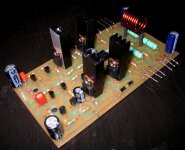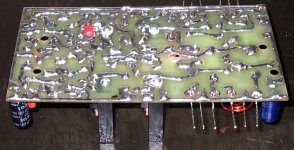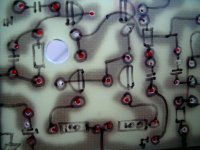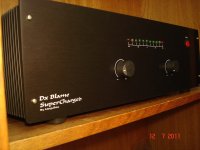I would like to know what the rules for "correct" wiring are because I am not sure. My rules are: 1) Keep AC lines away from DC lines as much as possible. 2) Shield low level input signals. What sort of things would one hear with "incorrect" wiring? I am extremely pleased with the sound of this amp. I thought the Yamaha M70 was a fine amplifier but this new amp seems to have so much more detail. I am very tempted to build another to replace my Carver A500 which drives my subs.
I like wire nuts because they make disassembly much easier. In my youth I soldered everything but the half dozen amps I have made since using wire nuts I have not encountered a problem with them.
I admire the pictures of the super neat wiring I see on some of the amps. But most of these amps don't have meters nor front input attenuators which really add to the spaghetti wiring.
I like wire nuts because they make disassembly much easier. In my youth I soldered everything but the half dozen amps I have made since using wire nuts I have not encountered a problem with them.
I admire the pictures of the super neat wiring I see on some of the amps. But most of these amps don't have meters nor front input attenuators which really add to the spaghetti wiring.
It's only DIY, so go by whatever you like as long as the end outcome, i.e. the sound, is something you are satisfied with.
On the other hand, during my day job, I design professional products and the main rule is as few wires as possible.
1) Wires allow for assembly mistakes.
2) Wires act as antennas, can radiate EMI to other circuits.
3) Wires act as antennas, can be victim to nearby EMI (e.g. clock) sources.
4) Wires and connectors create impedance discontinuity, creating distortion.
5) Wires should preferably be shielded type.
6) Wires carrying signal must be separated from wires carrying power.
7) No soldered-in wires, must have connectors, allowing dissassembly for repairs, test, etc.
8) Connectors used must be locking types, to prevent accidental disconnects.
9) Connectors used must be unique, to prevent mistakes.
Some DIY folks like super neat wiring. Remember the craze with DIY gaming computers a while back? Well, it's easy to use wire looms in those boxes but to do so in a DIY audio box might be bad. Watch how you dress your wires and avoid the pitfalls listed above. Have fun.
On the other hand, during my day job, I design professional products and the main rule is as few wires as possible.
1) Wires allow for assembly mistakes.
2) Wires act as antennas, can radiate EMI to other circuits.
3) Wires act as antennas, can be victim to nearby EMI (e.g. clock) sources.
4) Wires and connectors create impedance discontinuity, creating distortion.
5) Wires should preferably be shielded type.
6) Wires carrying signal must be separated from wires carrying power.
7) No soldered-in wires, must have connectors, allowing dissassembly for repairs, test, etc.
8) Connectors used must be locking types, to prevent accidental disconnects.
9) Connectors used must be unique, to prevent mistakes.
Some DIY folks like super neat wiring. Remember the craze with DIY gaming computers a while back? Well, it's easy to use wire looms in those boxes but to do so in a DIY audio box might be bad. Watch how you dress your wires and avoid the pitfalls listed above. Have fun.
If you disconnect frequently, install an overrated plug; the wire nuts are not really supposed to be reusable. It's not that the wire nuts are really so terrible, it just looks kind of kludgy, like putting your cabinet together with duct-tape. But it's original thinking and fine for a test-jig. I didn't mean to offend, just poking some respectful fun. Heck, we've seen amps assembled on a breadboard...and I mean a wooden kitchen board for slicing bread on. Or students who build on nothing but air making a delicate but good-sounding sculpture-like 3-dimensional layout with solid connecting wires providing the only support, or test-wired entirely with alligator-clip wires. Bottom line, I'd rather see your wire nuts than have everyone think alike.
Amplifier testbed
Heres a test bed i use to test my projects: http://i.imgur.com/hlTue.jpg
Ironically though this thing have now been on 24/7 for weeks, playing sweet music, i've even been sleeping in my couch with this thing playing music on low volume.
Heres a test bed i use to test my projects: http://i.imgur.com/hlTue.jpg
Ironically though this thing have now been on 24/7 for weeks, playing sweet music, i've even been sleeping in my couch with this thing playing music on low volume.
That is good stuff Arius and food for thought. What would you hear if you had EMI contamination in your amplifier circuit?
Hi Richard,
If your audio circuit is susceptible to EMI, the result would typically be increased noise levels. Bipolar transistors in your circuit (be they discrete or IC) can act as rectifiers. Even some forum members have experienced this in an audible way - they hear faint radio stations. A low level rectified RF signal can badly reduce your SNR. That's why you see some competently circuits with input RF filters.
In the end, no point diving any further into theory. This thread is to show your pics and thank you for sharing. Keep DIY-ing.
Fótios... nice job you use to make...congratulations
... the same to Alex mm.
dear fótios, you may like this:
YouTube - Audio amplifier aluminium panel chemical treatment
regards,
Carlos
... the same to Alex mm.
dear fótios, you may like this:
YouTube - Audio amplifier aluminium panel chemical treatment
regards,
Carlos
Fotios is a very nice greek ....he use to produce lovely high end
amplifiers using beautifull boards and he is skilled while using mechanicall tools, he makes perfect enclosures that can compete with the best and most expensive wide world power amplifiers.
He is in this post:
http://www.diyaudio.com/forums/soli...ur-solid-state-pics-here-182.html#post2561033
As i have not his personnal adress to send the video link, them i use this thread as i am sure he use to visit this thread, he is subscribed to this thread.
Sorry if i have bothered.
regards,
Carlos
amplifiers using beautifull boards and he is skilled while using mechanicall tools, he makes perfect enclosures that can compete with the best and most expensive wide world power amplifiers.
He is in this post:
http://www.diyaudio.com/forums/soli...ur-solid-state-pics-here-182.html#post2561033
As i have not his personnal adress to send the video link, them i use this thread as i am sure he use to visit this thread, he is subscribed to this thread.
Sorry if i have bothered.
regards,
Carlos
Want to travel to the past in a time machine?
Look the way we used to make amplifiers 40 years ago.... without computers, or software, or scanners or printers... the stuff was not discovered..only thermal printers and some Z80 computers.
The way this was made... with pen, nail polish, drawing and corroding using chemical products available since the fifties constitutes in a free ticket for your to travel to the past.... the ones who lived through that era will remember ... and young people will understand as we did when there were no computers that could help us.
A diy, handmade and homemade board style.
regards,
Carlos
Look the way we used to make amplifiers 40 years ago.... without computers, or software, or scanners or printers... the stuff was not discovered..only thermal printers and some Z80 computers.
The way this was made... with pen, nail polish, drawing and corroding using chemical products available since the fifties constitutes in a free ticket for your to travel to the past.... the ones who lived through that era will remember ... and young people will understand as we did when there were no computers that could help us.
A diy, handmade and homemade board style.
regards,
Carlos
Attachments
Last edited:
Look the way we used to make amplifiers 40 years ago.... without computers, or software, or scanners or printers... the stuff was not discovered..only thermal printers and some Z80 computers.
The way this was made... with pen, nail polish, drawing and corroding using chemical products available since the fifties constitutes in a free ticket for your to travel to the past.... the ones who lived through that era will remember ... and young people will understand as we did when there were no computers that could help us.
A diy, handmade and homemade board style.
regards,
Carlos
I like it. So, nail polish works well as etch-resist? Permanent marker is not so good for me.
I just started etching PCBs, so I still have a lot to learn. I have been using the laser printer at work and hydrochloric acid/hydrogen peroxide mixture. The printer I think is not good quality because the transfer of the toner to the PCB is never perfect, no matter what I try. That blue stick n peel stuff is expensive so I will not try that. I cover every trace with a layer of solder and clean it well to protect against the possibility of hairline trace cracks.
Carlos! Give me some tips on how to make an enclosure for my DX Precision I. I have the guts of the enclosure, and the bottom. I also have a top cover. But, I am stuck on the rest. I don't have access to many tools outside of what I need for electronics work.
An externally hosted image should be here but it was not working when we last tested it.
An externally hosted image should be here but it was not working when we last tested it.
Last edited:
Nail polish is resistant to acid attack... reason why i am using it
thank you..... in the reality i am not that good about enclosures, the ones i have made are terrible... the one i know is very good is Fótios from this forum..... he is awesome...not a diy i think...he may do diy (amateur)
but the guy works alike, and even better, than a Pro.
My email adress is:
nanabrother@hotmail.com
I can try to help you, but i know nothing about enclosures, will be easier you to help me than the opposite...well...i can try.
regards,
Carlos
thank you..... in the reality i am not that good about enclosures, the ones i have made are terrible... the one i know is very good is Fótios from this forum..... he is awesome...not a diy i think...he may do diy (amateur)
but the guy works alike, and even better, than a Pro.
My email adress is:
nanabrother@hotmail.com
I can try to help you, but i know nothing about enclosures, will be easier you to help me than the opposite...well...i can try.
regards,
Carlos
I can try to help you, but i know nothing about enclosures, will be easier you to help me than the opposite...well...i can try.
regards,
Carlos
I either buy a new case or buy a faulty amp with a good case and use that.
PC cases are quite good because they look great and have lots of fitments for fans, PSU etc.
I usually strip out the power supply and use the mains socket on it.
I either buy a new case or buy a faulty amp with a good case and use that.
PC cases are quite good because they look great and have lots of fitments for fans, PSU etc.
I usually strip out the power supply and use the mains socket on it.
The case parts I posted in the pics are exactly that -- from a denon power amp. The trafo and top, bottom parts and insides including heatsinks. I could have used the front back and side panels but I don't want it to have denon on it or other writing, or unused holes where parts used to be.f
Posting from phone sorry.
I'm thinking wood with paint. I dojt know about skills with nice finishes.
I do not know too..all i know is to scratch surface using sandpaper and steel brush
and to apply chemical to attack metal and produce some effect (ferric chloride and 3 other chemical agents)... i know how to paint and produce ink and colours at home, how to apply varnish, how to prepare wood.... how to saw metal, how to produce holes in metal, how to bend metal...but this is all.
Compared with fótios (the king) i am very stupid related these things.
Watch what Horácio, a Brazilian did, looks paint.
regards,
Carlos
and to apply chemical to attack metal and produce some effect (ferric chloride and 3 other chemical agents)... i know how to paint and produce ink and colours at home, how to apply varnish, how to prepare wood.... how to saw metal, how to produce holes in metal, how to bend metal...but this is all.
Compared with fótios (the king) i am very stupid related these things.
Watch what Horácio, a Brazilian did, looks paint.
regards,
Carlos
Attachments
I don't like it.I like it.
An externally hosted image should be here but it was not working when we last tested it.
What is the purpose of posting a 1280px by 768px, 274.92 kB (281,521 bytes) fuzzy pic?
you are not stupid.Compared with fótios (the king) i am very stupid related these things.
Just admit you are not prepared to invest the time and resources in learning.
- Home
- Amplifiers
- Solid State
- Post your Solid State pics here



